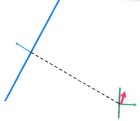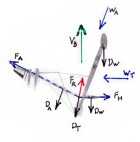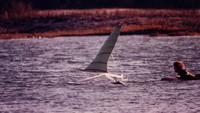High-Speed Sailing
| Vessel Name: | Sailien |
| Vessel Make/Model: | Experimental/custom |
28 September 2013
The America’s Cup
I watched, with interest, the videos of the 34th America’s Cup. At last we have fast sailboats engaged in a competition that is fun to watch. The virtual images (such as course boundaries, distance grid lines, separation between boats, etc.) overlaid on the real images really helps to keep the race [...]
31 August 2013
100 Knots for Hydroptere?
The latest news from Hydroptere is that they have plans for a 100 knot sailboat. This was posted on 26 Aug 2013, so look for that date at this address. http://hydroptere.com/en/the-news/last-news/
17 November 2012
Aptly named Sailrocket, blasts off!
While yet to be ratified, Sailrocket posted an average speed over 500 meters of 59 knots. I will not be surprised if they increase their record into the 60 knot range during this record attempt.
02 January 2012
More drag for VSR2?
I want to start by pointing out that the whole VSR2 team has done a stellar job and has demonstrated conclusively that the forces that drive a sailboat can be aligned for roll stability without using ballast and without using any down-force. (Trifoiler achieved roll stability by using down-force, but [...]
18 December 2011
My analysis of Sailrocket
I copied a diagram of VSR2 (wing doesn’t show well) and added in the major force arrows that apply. Be aware that these arrows are not correct in terms of scale (length) and some of their locations are guesses, however I believe I’m correct enough for us to learn something about what VSR2 has been [...]
23 October 2011
60 is within reach, what’s next?
I have been watching Sailrocket’s progress with great interest and there’s no question they have a winner. I fully expect to see them reach 60kt in the near future. Sailrocket has now demonstrated what I first learned with my models and again with my full-sized prototypes, that if you get the forces [...]
Comparing the craft by weight use
I was looking at the Wing-Borne Hydrofoil a bit more and noticed that it is described as being "self-righting". If you look at the image, you will notice a torpedo shaped appendage under water, I suspect this is ballast that provides for the self-righting properties.
At this point in my discussion on weight, I will define some terms to ensure we're all in agreement on those terms. Ballast: which my dictionaries define as heavy material placed in the hold of a ship to enhance stability -- thought to derive from Old Danish "barlast" (bare load - cargo carried only for its weight). Payload: which is described as the cargo you are getting paid to transport. Of course, in recreational sailing, we're not getting paid money to sail, but we are getting paid in fun (vastly more valuable than any amount of money). So our payload is our self, friend, picnic lunch, etc.
The overall weight of our craft can be seen to come from three sources; the materials the craft is made of, our payload, and (if needed) ballast. Since we have already seen that weight sets our craft lower in the water, slowing it, it is to our advantage to get rid of any weight we don't need if we want to go faster. It is true that in many designs ballast is needed and helps that design to go faster, but that is a dead-end which ultimately limits speed.
Our options for trimming the weight are to optimize those three sources of weight. By using the best in modern materials and structural engineering, we can trim the weight of the craft. By reducing the number of crew needed, we can trim our payload weight (this may only be a benefit if we want to run a small, less expensive craft - note Hydroptere's success with a large, fully crewed craft). But by redesigning the craft so we can eliminate all ballast, we have the potential for the most gain.
The real key however, is not light weight, it is stability. It is essential that we have the stability needed to sail in the conditions we wish to sail in and if we want to go really fast, we will find ourselves sailing in some fairly strong winds.
From what I have been able to learn, the following is how weight is being used by the various contenders. Note that I have not verified this and if any of you know more, please correct/update me. I should point out that using the crew for any needed balance is an efficient use of the payload.
-Hydroptere puts most of the crew on the windward arm to help improve their stability. I thought I had read that they have water ballast tanks but do not see mention of this on their web site. Anyone know about this?
-Macquarie Innovation uses the crew in a long lever arm to balance the craft.
-Wotrocket also places the crew in a long lever arm to balance the craft.
-Wiebel uses the crew for balance.
-Windsurfers and Kite-boarders use their body weight for balance and I understand they have also been wearing weight-belts for ballast. The next significant advance for them would be to tie a paravane to their backside, eliminate any ballast and join the following projects.
The projects below do not use weight for stability (neither ballast nor payload).
-Le Projet Dared
-Paravane
-Trifoiler
-Sailrocket
-Windjet (water-craft version)
-Sailien
Bob
About & Links
- Bob's Surfing Blog
- Bob's Website
- Greenbird (Windjet)
- l'Hydroptere
- Le Projet Dared
- Macquarie Speed Sailing Team
- Monofoil Sailing
- Mountain Goat STOL
- Mr Smith's Amazing Sailboats
- Patent Office (Search)
- Radboat
- Sailien Prototypes (early), Delta, etc.
- Sailien Video
- Sailien Website
- The Basics of Surfboard Design
- The Basics of Surfboard Design en Espanol
- The Swedish Speed-Sailing Challenge
- Trifoiler
- Vestas Sailrocket
- Windjet Project
- WSSRC


